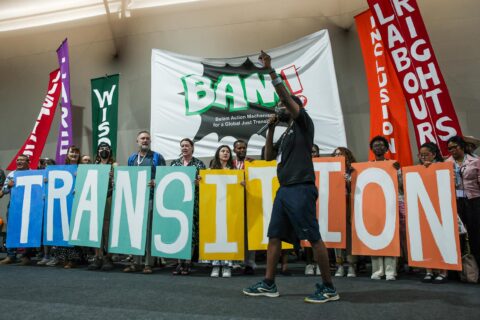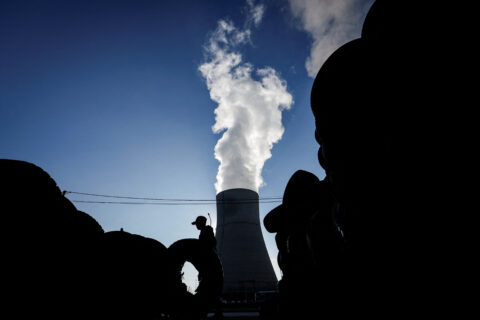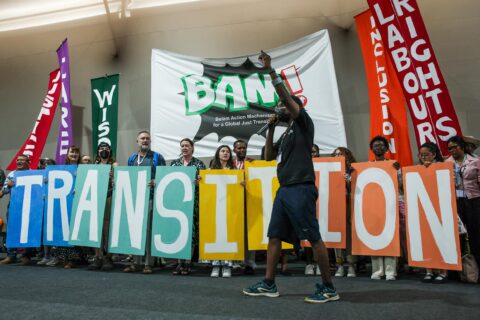At the COP15 biodiversity summit in December 2022, nearly every country in the world committed to a new global agreement to “halt and reverse” biodiversity loss by 2030 and “restore harmony with nature” by 2050.
Under the Kunming-Montreal Global Biodiversity Framework (GBF), countries pledged to release new national plans for how they will achieve a range of goals and targets.
These plans are known as national biodiversity strategies and action plans (NBSAPs).
The GBF requires countries to submit new NBSAPs ahead of COP16, the next global biodiversity summit being held in Cali, Colombia in October.
Below, Carbon Brief tracks which countries have submitted new NBSAPs and analyses how each country has pledged to meet the key targets outlined in the GBF.
Table design by Tom Pearson. NBSAP translations by Anika Patel, Yanine Quiroz and Alice Vernat-Davies. A full spreadsheet of this data is available to view.
What are NBSAPs and why are they important for global action on nature loss?
NBSAPs are blueprints for how individual countries plan to tackle biodiversity loss within their borders, as well as ensure they meet the international targets outlined in the GBF.
Each country that is party to the UN’s Convention on Biological Diversity (CBD) is expected – but not legally required – to submit NBSAPs.
There are 196 parties to the CBD including the EU. This includes every country of the world except the US and the Holy See, the governing body of the Vatican. (Republican lawmakers have blocked the US from joining the CBD, citing concerns over “American sovereignty” and “financial burdens”.)
Under the GBF, countries agreed to submit updated NBSAPs ahead of COP16, which is scheduled for 21 October to 1 November 2024 in Colombia.
NBSAPs are similar to nationally determined contributions (NDCs), plans that outline how individual countries envisage meeting the goals of the Paris Agreement. However, a key difference is that countries are legally obliged to submit NDCs, but not NBSAPs.
(The Paris Agreement is an international treaty agreed in 2015 aimed at keeping global temperatures well below 2C, with an ambition of limiting them to 1.5C, by the end of the century.)
The GBF contains a set of four goals and 23 targets, which collectively aim to reverse the rapid decline of biodiversity by 2030 and “restore harmony with nature” by 2050.

One of the most publicised targets is target 3, which commits countries to protecting 30% of their land and seas for nature by 2030 (commonly known as “30 by 30”). The full list of targets is included below.
| Target | Description |
|---|---|
| 1 | Effective management of land- and sea-use change, loss of highly important biodiverse areas close to zero by 2030 |
| 2 | Effective restoration of 30% of degraded ecosystems by 2030 |
| 3 | Effective conservation and management of 30% of land and 30% of oceans by 2030 |
| 4 | Halt human-induced extinctions and maintain and restore genetic diversity |
| 5 | Sustainable use, harvesting and trade of wild species |
| 6 | Mitigate or eliminate the impacts of invasive alien species, reduce the rates of establishment of invasive species by 50% by 2030 |
| 7 | Reduce pollution risks and impacts from all sources by 2030, reduce the overall risk from pesticides by half |
| 8 | Minimise the impacts of climate change and ocean acidification on biodiversity |
| 9 | Ensure sustainable use and management of wild species, while protecting customary use by Indigenous peoples |
| 10 | Sustainable management of areas under agriculture, aquaculture, fisheries and forestry |
| 11 | Restore and enhance ecosystem function through nature-based solutions and ecosystem-based approaches |
| 12 | Increase the area and quality of urban green and blue spaces |
| 13 | Fair and equitable sharing of the benefits arising from the use of genetic resources |
| 14 | Integration of biodiversity into policies and development across all sectors |
| 15 | Enable businesses to monitor, assess and disclose their impacts on biodiversity |
| 16 | Encourage sustainable consumption, including by reducing food waste by half by 2030 |
| 17 | Strengthen capacity for biosafety measures and ensure benefits-sharing from biotechnology |
| 18 | Phase out or reform harmful subsidies in a just way, reducing them by $500bn by 2030 |
| 19 | Substantially increase financial resources, mobilise $200bn per year by 2030 from all sources, including $30bn from developed to developing countries |
| 20 | Strengthen capacity-building and technology transfer |
| 21 | Integrated and participatory management, including the use of traditional knowledge |
| 22 | Equitable representation and participation of Indigenous peoples and local communities |
| 23 | Ensure gender equality in the implementation of the framework |
In their NBSAPs, countries are expected to set out how they will work towards achieving these goals and targets.
But while countries are working towards a shared set of goals, each NBSAP will be highly unique. This is because every country has its own unique blend of species and habitats – and its own challenges when it comes to conserving them.
For example, Ireland’s NBSAP speaks about restoring commercial fish stocks in Irish waters to sustainable levels and repairing the nation’s highly degraded peatlands.
By contrast, Japan’s NBSAP talks about ensuring “appropriate distance between human beings and wildlife is maintained”, likely referring to its booming nature tourism industry.

Which countries have submitted NBSAPs?
As of 2 May 2024, just seven countries and the EU had fulfilled the request to submit an updated NBSAP.
That leaves 188 countries that are yet to submit updated NBSAPs.
The map below shows countries that have submitted updated NBSAPs in green.

At the COP28 climate summit in December 2023, the UK indicated that it will release its updated NBSAP by May.
COP16 host Colombia is among the countries that are yet to submit an updated NBSAP.
What are some key takeaways from the updated NBSAPs?
Reversing biodiversity loss
Examining NBSAPs can offer clues into how countries are responding to the targets set out in the GBF – and their views on traditionally contentious issues such as biodiversity finance, Indigenous rights and the sharing of genetic resources.
The headline “mission” of the GBF is to halt and reverse biodiversity loss by 2030.
While many people associate “biodiversity” with iconic species and tropical rainforests, the term actually covers the whole spectrum of Earth’s biological diversity, ranging from the organisation of genes within organisms to the communities of animals and plants that make up ecosystems.
Last year, a group of biologists explained to Carbon Brief that halting and reversing all biodiversity loss by 2030 would be a “huge challenge”, with one expert saying they were “highly doubtful” it was scientifically possible.
Out of the small group of countries that had released updated NBSAPs at the time of publication, the vast majority did not mention halting and reversing biodiversity loss by 2030 in their plans.
The EU and some of its member states, such as Ireland and Luxembourg, did make a reference to halting and reversing the loss of pollinators, a target set out in the EU biodiversity strategy.
France’s plan says that it will aim to reverse the decline of “threatened flagship species, especially endemic species in overseas territories”.
All of these references are a far cry from reversing the loss of all biodiversity.
The only country to explicitly mention this target in its NBSAP was China, the host nation for COP15.
Invasive species and pesticides
There are some areas of convergence among the very small number of countries that have released updated NBSAPs.
Target 6 of the GBF is to “mitigate or eliminate the impacts of invasive alien species” and to “reduce the rates of establishment of invasive species by 50% by 2030”.
The EU, China and Japan all mention targets to reduce the impact of invasive species.
However, there are differences in what the targets aim to achieve. For example, EU nations are targeting a 50% reduction in the number of Red List species threatened by invasive alien species, whereas China and Japan are targeting a 50% reduction in the rate of invasive species establishment.
Target 7 of the GBF is to “reduce the overall risk from pesticides by half”. (It is worth noting that some parties wanted a more ambitious target to reduce the use – rather than the risk – of pesticides by half.)
In its NBSAP, the EU references a target whereby “the risk and use of chemical pesticides is reduced by 50% and the use of more hazardous pesticides is reduced by 50%”.
This wording is repeated in the NBSAPs of many of its member states – so far, Ireland, France, Luxembourg and Spain.
By contrast, Japan references a need for a “reduction in risk-weighted use of chemical pesticides”, while China commits to “reduce” pesticides and to “gradually phase out highly toxic and high-risk pesticides”.
Biodiversity finance
When it comes to the topic of developed nations providing more finance to help developing nations protect biodiversity – one of the most contentious issues at COP15 – there is little consistency among NBSAPs.
Japan makes the clearest pledge when it comes to supporting developing nations, with a target that says the country will aim to ensure “financial resources for the conservation of biodiversity are secured to improve biodiversity global finance gap”.
Japan will also aim to ensure that “capacity-building…in developing countries by Japan’s support are further implemented”.
Ireland also mentions a target to “strengthen the inclusion of biodiversity in international diplomacy and financing”.
In addition, Japan makes reference to target 18 of the GBF, which is to “phase out or reform harmful subsidies in a just way, reducing them by $500bn by 2030”. (“Harmful subsidies” refer to those that prop up industries known to harm nature, such as large-scale meat farming and fossil-fuel extraction.)
Japan says it will “consider” the “identification and reforms of subsidies harmful for biodiversity”.
Spain has a more clear target for subsidy reform, stating:
“By 2025, 50% of identified harmful subsidies will be reformed, redirected or eliminated and ensure that by 2030 all subsidies or incentives are neutral or positive for natural heritage and biodiversity and adequately incorporate environmental externalities.”
The post COP16: Tracking country pledges on tackling biodiversity loss appeared first on Carbon Brief.
COP16: Tracking country pledges on tackling biodiversity loss
Climate Change
Week Two at COP30: What Happens When the World Can’t Agree
I’m writing this from Boston, not Belém. I left COP30 a day before it ended—exhausted, frustrated, and strangely hopeful all at once.
Brazil’s presidency pushed hard to close the deal, with President Lula returning to witness what they hoped would be a historic finish. Draft texts circulated rapidly. But negotiators were still debating language that over 80 countries wanted included, while others refused. The venue briefly shut down after a fire, then reopened. Civil society held a “funeral for fossil fuels” in the streets while diplomats removed any mention of a fossil fuel phase-out from the draft agreement.
This is what Week Two taught me: global climate policy is messy, imperfect, and maddeningly slow. And yet, something important is still happening.
The Hard Truth About Consensus
Here’s what didn’t make it into the final text: a roadmap for a fossil fuel phase-out. Over 80 countries pushed for it. Small island nations whose existence depends on it advocated for it. Youth activists and Indigenous leaders demanded it. And it was removed.
Some negotiating blocs, including the Arab Group and Like-Minded Developing Countries, opposed any language on fossil fuels in the final agreement. In consensus-based negotiations, that’s all it takes. One bloc says no, and the whole thing stalls.
But here’s what educators and students need to understand: the absence of that language doesn’t mean the conversation isn’t shifting. Three years ago, fossil fuel phase-out wasn’t even on the agenda. Now it’s what over 80 countries are fighting for. That’s movement, even when it doesn’t feel like it.
The Shift No One’s Talking About
Here’s what I’ve learned after attending multiple global forums: the real negotiations aren’t happening where you think they are.
Brazil’s aggressive push to finish on time revealed something important — when host countries center their own priorities (in this case, Indigenous leadership and Amazon protection), it fundamentally changes what’s “negotiable.” The fossil fuel language got removed, yes, but Indigenous participation went from roughly 200 people at previous COPs to over 900 at COP30. That’s a 350% increase.
This is strategic presence in action. When you change who’s in the room, you change what’s possible — even if outcomes aren’t immediate.
After years of working in global meetings and events, I’ve developed what I call the Presence-to-Policy approach. It has four elements: who’s in the room (strategic presence), how they engage (cultural intelligence), what networks form (relationship architecture), and what outcomes emerge (policy influence). COP30 demonstrated this perfectly — increase Indigenous presence from 200 to 900+ participants, and you don’t just add voices. You shift what’s considered legitimate knowledge, what matters as a priority, and which solutions are explored.
For educators: this is the lesson. Representation isn’t symbolic. It’s tactical.
When Money Becomes the Sticking Point
Adaptation finance became one of the headline topics this year — and one of the most contentious. Countries were pushed to triple adaptation finance to $120 billion, but by the end of Week Two, no new concrete commitments emerged. The Adaptation Fund is facing a significant deficit while wealthy nations negotiate how much they’ll actually contribute.
This is where cultural intelligence matters. In many Western diplomatic contexts, finance discussions and moral discussions often operate separately. But many Global South delegations frame climate finance as reparations, as justice, as basic accountability. When you understand that framing, you know why these negotiations feel so urgent, so non-negotiable.
One encouraging shift: finance ministries and environment ministries are finally working together on climate issues. Initiatives like the Coalition of Finance Ministers for Climate Action are bringing economic decision-makers into conversations previously dominated by environmental officials. This convergence matters more than most headlines suggest — it’s the structural change that enables everything else.
What Stayed Strong
Despite frustrations, some things held. Indigenous representation remained centered throughout Week Two. Over 900 Indigenous participants continued to lead conversations, present traditional knowledge systems, and refuse to be sidelined. Even when access to decision-making spaces remained imperfect, they fundamentally changed what this COP prioritized.
Civil society showed up relentlessly. The “funeral for fossil fuels” wasn’t just theater — it was thousands refusing to let negotiators ignore what science demands. Health workers added urgent voices, bringing research showing that fossil fuels drive 7 million premature deaths annually from air pollution alone. Yet even as medical professionals demonstrated direct connections between fossil fuels and human suffering, these fuels remained largely absent from official negotiations.
For Climate Generation’s Work
This connects directly to overcoming disinformation. Because one form of disinformation is the narrative that global forums are useless, that diplomacy doesn’t work, that nothing ever changes. The truth is more complex: change happens slowly, unevenly, and through sustained pressure from multiple directions.
And when negotiations fail to produce what’s needed, localized action becomes even more critical. That’s where actual implementation happens — in communities, classrooms, and organizations that refuse to wait for international consensus. This is Climate Generation’s approach to personalizing and localizing climate change action in practice.
Three Classroom Applications
For educators working with Climate Generation’s mission, here are practical ways to use COP30:
1. Teach coalition-building, not just science. Have students map the 80+ country alliance pushing for fossil fuel language. What do Small Island Developing States, European nations, and Latin American countries have in common? This teaches geopolitics through climate.
2. Explore the disinformation narrative. The “COPs don’t work” message serves fossil fuel interests. Help students analyze who benefits from climate action paralysis. This builds critical thinking about the systems that perpetuate the crisis.
3. Examine power through presence. Compare Indigenous participation at previous COPs with that at COP30. What changed when representation increased by 350%? How did this shift priorities? This connects directly to Climate Generation’s work centering anti-racism and systemic equity.
What COP30 Means for Antalya
COPs are often judged immediately and deemed “failures.” But their real impact shows up 2-3 years later when relationships built here materialize into policy shifts.
Watch what happens at COP31 in Antalya, Turkey, next year. The over-80-country coalition pushing for fossil fuel language won’t disappear. The health workers making connections between fossil fuels and human suffering won’t stop. The finance and environment ministries learning to work together will keep building bridges.
Climate Generation’s work preparing the next generation matters because these young people will inherit these coalitions, these relationships, these incremental shifts. They need to understand not just the science of climate change, but the mechanics of how power actually moves.
That’s not taught in most classrooms. But it should be.
Coming Home
As I sit in Boston processing these two weeks, I keep thinking about that environmental justice leader from the Gulf Coast, the Indigenous forest guardians who traveled days to make their voices heard, and the youth activists holding a funeral for fossil fuels in the streets.
They’re not waiting for perfect agreements. They’re building movements that outlast individual COPs, that shift power gradually, that create change from multiple directions at once.
That’s what Climate Generation does — it builds sustained capacity to act through centering marginalized communities, working with BIPOC partners on the convergence of racial and climate justice, and engaging educators and students where disinformation is most prevalent.
COP30 didn’t deliver everything it needed to. But it delivered relationships, knowledge, pressure, and possibility. That’s not nothing.
The work continues — in Belém, in Antalya next year, in communities worldwide, and in every classroom — refusing to accept an inadequate status quo.
___
About This Partnership: Climate Generation provided COP30 credentials to Terra40 in exchange for on-the-ground insights and educational content. Learn more at climategen.org. Learn more about Terra40’s global climate engagement work at terra40.com.
The post Week Two at COP30: What Happens When the World Can’t Agree appeared first on Climate Generation.
Climate Change
COP30 fails to land deal on fossil fuel shift but triples finance for climate adaptation
After all-night talks, governments at COP30 agreed on Saturday to launch limited initiatives to strengthen emissions-cutting plans, as well as tripling finance to help poor countries cope with worsening climate change impacts by 2035. But the Amazon summit’s outcomes fell short on the global transition away from oil, gas and coal.
In an effort to deliver something on fossil fuels, the Brazilian presidency complemented the final Belém package by promising to create roadmaps on transitioning away from fossil fuels and protecting forests – as requested by Brazilian President Lula da Silva.
Brazil tabled its roadmap proposal at the eleventh hour as a compromise solution after some nations – especially European and Latin American states – voiced disappointment that a formal deal was not reached on one after strong pushback from large fossil fuel producers led by Saudi Arabia.
Brazil’s roadmap process will sit outside the UN climate regime. It will be supported by other countries such as Colombia, which is organising the first global conference on the issue, said COP30 president André Aranha Corrêa do Lago. He added that he will also craft a second roadmap to halt and reverse deforestation and report back to the COP on them both.
“We know some of you had greater ambition for some of the issues at hand,” Corrêa do Lago told a closing plenary. “I will try not to disappoint you.”
After week-long row, COP30 fails to mention fossil fuels
After more than 80 countries called for a roadmap to phase down oil, coal and gas to be kickstarted at COP30, observers said fossil fuel heavyweights, including Gulf States, Russia and India, had insisted it stay out of the final Global Mutirão decision adopted in Belém, along with any explicit mention of fossil fuels.
On Friday, the European Union and the UK had fought hard against that opposition but ultimately had to settle for two new processes that are meant to reinforce ambition and implementation of countries’ national climate plans (NDCs), with reports and a high-level dialogue due next year.
Before the final plenary, EU Climate Commissioner Wopke Hoekstra said it had been “an intense and sometimes difficult week and evening”, adding “we would have liked to have more”. But, he said, “we think we should support [the COP outcome] because at least it is going in the right direction.”
The Mutirão text encourages countries ”to strengthen their existing nationally determined contribution at any time with a view to enhancing its level of ambition” and calls on them to accelerate their implementation “while striving to do better collectively and cooperatively”.
In a last-minute push, Colombia – which championed a declaration to transition away from oil, coal and gas – told the closing plenary the country was “left with no other choice” but to object to the outcome of the dedicated mitigation track on emission-cutting efforts unless a mention to fossil fuels was added. After the presidency tried to dismiss concerns, Colombia insisted and the plenary was suspended.
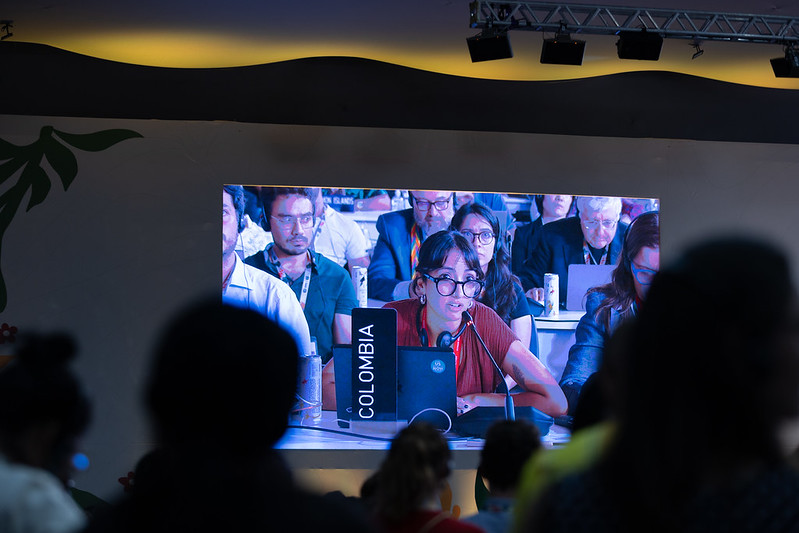

Developed countries – especially the EU – had felt isolated in their push for stronger language on emission-cutting measures after failing to win vocal support from traditional allies such as the Alliance of Small Island States (AOSIS) and the Least Developed Countries (LDCs).
That was mainly because of Europe’s inability to make a compelling offer on finance for adaptation, negotiators and observers said.
“Adaptation COP” triples finance for climate resilience
A demand from the world’s poorest nations to triple adaptation finance was agreed, but only by a deadline of 2035 rather than 2030, and without a clear number.
However, the main Mutirão decision urges developed countries to increase their collective provision of climate finance for adaptation to the Global South. It also sets up a two-year process on climate finance as well as a high-level ministerial roundtable to discuss progress towards meeting the new climate finance goal agreed last year at COP29.
That COP29 goal sets a target for rich nations to provide $300 billion a year for climate action by 2035 – and the tripling of adaptation finance decided in Belem will be part of this, as the EU had insisted.
“It is very clear that we should stand shoulder to shoulder with the poorest nations,” the EU’s climate chief Wopke Hoekstra said before the final conference session began.
Some African ministers gave the outcome on adaptation finance a cautious welcome. But many countries – including the EU, some Latin American states, Switzerland and Canada – were angry about a text that adopted indicators to measure progress on adaptation efforts.
They made interventions rejecting the decision on a new Global Goal on Adaptation (GGA) – expected to be a flagship outcome at this COP – which included a rewritten and shortened list of metrics to measure progress on climate resilience originally developed by technical experts.
Jiwoh Abdulai, environment minister of Sierra Leone, said they had worked tirelessly to craft a set of indicators that would reflect “lived realities” on the ground, but are now left with “unclear, unmeasurable and – in many cases – unusable” ones.
“For us, this is not technical, this is about our survival,” he added before the plenary was suspended.
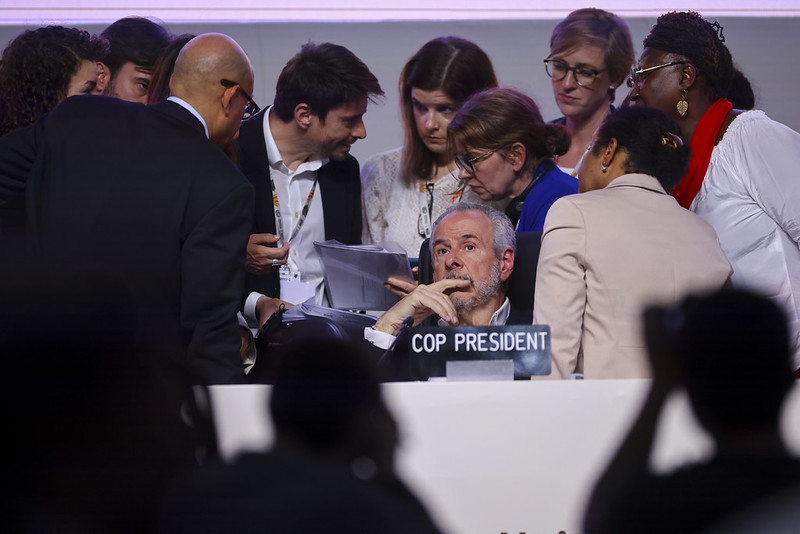

Trade and just transition land wins in Belém deal
As the Belem political package was adopted to muted applause from countries, campaigners at the back of the room whooped with joy as the conference approved a decision on just transition.
They and developing countries had swung behind a new “Belém Action Mechanism”, intended to serve as a hub to support countries in taking concrete steps to ensure their shift from dirty to clean energy systems is fair and equitable.
The Mutirão decision also includes trade, another key issue that was not on the official negotiating agenda, along with long-term climate finance and the gap in emissions-cutting ambition.
Annual dialogues will take place at the next three mid-year Bonn sessions on boosting international cooperation on trade – an emerging economy priority in the context of a carbon levy on imports proposed by the EU.
Experts said the inclusion of trade in a COP decision was a big win for China. “For the first time, trade is elevated alongside mitigation and finance as a critical third pillar for climate progress,” said Kate Logan, director of China Climate Hub at the Asia Society Policy Institute, adding that this “is likely to remain a key arena for China’s influence” in the climate regime.
The decision reaffirms that “measures taken to combat climate change, including unilateral ones, should not constitute a means of arbitrary or unjustifiable discrimination or a disguised restriction on international trade”.
The post COP30 fails to land deal on fossil fuel shift but triples finance for climate adaptation appeared first on Climate Home News.
https://www.climatechangenews.com/2025/11/22/cop30-brazil-deal-fossil-fuel-transition-fails-triples-finance-climate-adaptation/
Climate Change
COP30 fails to land deal on fossil fuel transition but triples finance for climate adaptation
After all-night talks, governments at COP30 agreed on Saturday to launch limited initiatives to strengthen emissions-cutting plans, as well as tripling finance to help poor countries cope with worsening climate change impacts by 2035. But the Amazon summit’s outcomes fell short on the global transition away from oil, gas and coal.
In an effort to deliver something on fossil fuels, the Brazilian presidency complemented the final Belém package by promising to create roadmaps on transitioning away from fossil fuels and protecting forests – as requested by Brazilian President Lula da Silva.
Brazil tabled its roadmap proposal at the eleventh hour as a compromise solution after some nations – especially European and Latin American states – voiced disappointment that a formal deal was not reached on one after strong pushback from large fossil fuel producers led by Saudi Arabia.
Brazil’s roadmap process will sit outside the UN climate regime. It will be supported by other countries such as Colombia, which is organising the first global conference on the issue, said COP30 president André Aranha Corrêa do Lago. He added that he will also craft a second roadmap to halt and reverse deforestation and report back to the COP on them both.
“We know some of you had greater ambition for some of the issues at hand,” Corrêa do Lago told a closing plenary. “I will try not to disappoint you.”
After week-long row, COP30 fails to mention fossil fuels
After more than 80 countries called for a roadmap to phase down oil, coal and gas to be kickstarted at COP30, observers said fossil fuel heavyweights, including Gulf States, Russia and India, had insisted it stay out of the final Global Mutirão decision adopted in Belém, along with any explicit mention of fossil fuels.
On Friday, the European Union and the UK had fought hard against that opposition but ultimately had to settle for two new processes that are meant to reinforce ambition and implementation of countries’ national climate plans (NDCs), with reports and a high-level dialogue due next year.
Before the final plenary, EU Climate Commissioner Wopke Hoekstra said it had been “an intense and sometimes difficult week and evening”, adding “we would have liked to have more”. But, he said, “we think we should support [the COP outcome] because at least it is going in the right direction.”
The Mutirão text encourages countries ”to strengthen their existing nationally determined contribution at any time with a view to enhancing its level of ambition” and calls on them to accelerate their implementation “while striving to do better collectively and cooperatively”.
In a last-minute push, Colombia – which championed a declaration to transition away from oil, coal and gas – told the closing plenary the country was “left with no other choice” but to object to the outcome of the dedicated mitigation track on emission-cutting efforts unless a mention to fossil fuels was added. After the presidency tried to dismiss concerns, Colombia insisted and the plenary was suspended.
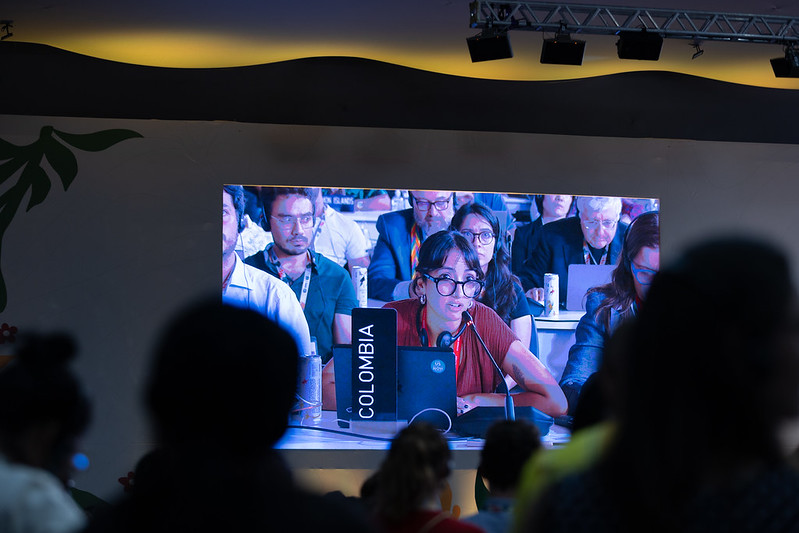

Developed countries – especially the EU – had felt isolated in their push for stronger language on emission-cutting measures after failing to win vocal support from traditional allies such as the Alliance of Small Island States (AOSIS) and the Least Developed Countries (LDCs).
That was mainly because of Europe’s inability to make a compelling offer on finance for adaptation, negotiators and observers said.
“Adaptation COP” triples finance for climate resilience
A demand from the world’s poorest nations to triple adaptation finance was agreed, but only by a deadline of 2035 rather than 2030, and without a clear number.
However, the main Mutirão decision urges developed countries to increase their collective provision of climate finance for adaptation to the Global South. It also sets up a two-year process on climate finance as well as a high-level ministerial roundtable to discuss progress towards meeting the new climate finance goal agreed last year at COP29.
That COP29 goal sets a target for rich nations to provide $300 billion a year for climate action by 2035 – and the tripling of adaptation finance decided in Belem will be part of this, as the EU had insisted.
“It is very clear that we should stand shoulder to shoulder with the poorest nations,” the EU’s climate chief Wopke Hoekstra said before the final conference session began.
Poorest countries appeal for more adaptation finance at COP30
Some African ministers gave the outcome on adaptation finance a cautious welcome. But many countries – including the EU, some Latin American states, Switzerland and Canada – were angry about a text that adopted indicators to measure progress on adaptation efforts.
They made interventions rejecting the decision on a new Global Goal on Adaptation (GGA) – expected to be a flagship outcome at this COP – which included a rewritten and shortened list of metrics to measure progress on climate resilience originally developed by technical experts.
Jiwoh Abdulai, environment minister of Sierra Leone, said they had worked tirelessly to craft a set of indicators that would reflect “lived realities” on the ground, but are now left with “unclear, unmeasurable and – in many cases – unusable” ones.
“For us, this is not technical, this is about our survival,” he added before the plenary was suspended.
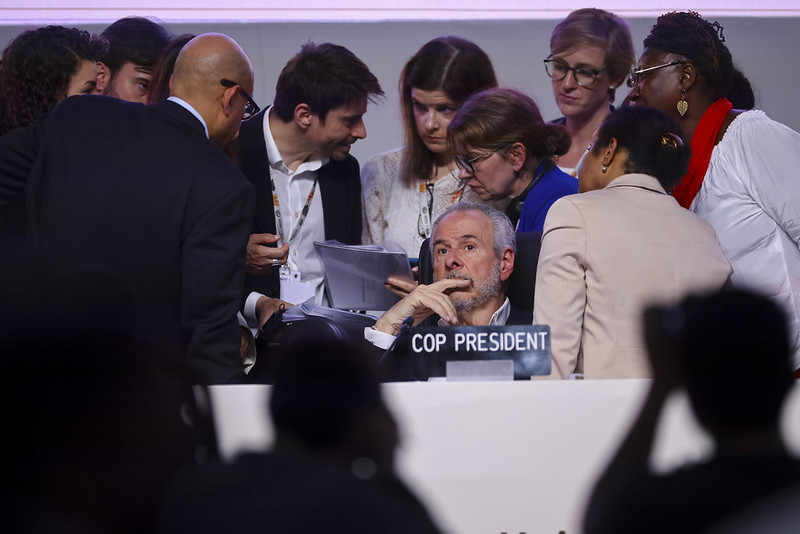

Trade and just transition land wins in Belém deal
As the Belem political package was adopted to muted applause from countries, campaigners at the back of the room whooped with joy as the conference approved a decision on just transition.
They and developing countries had swung behind a new “Belém Action Mechanism”, intended to serve as a hub to support countries in taking concrete steps to ensure their shift from dirty to clean energy systems is fair and equitable.
The Mutirão decision also includes trade, another key issue that was not on the official negotiating agenda, along with long-term climate finance and the gap in emissions-cutting ambition.
Annual dialogues will take place at the next three mid-year Bonn sessions on boosting international cooperation on trade – an emerging economy priority in the context of a carbon levy on imports proposed by the EU.
Experts said the inclusion of trade in a COP decision was a big win for China. “For the first time, trade is elevated alongside mitigation and finance as a critical third pillar for climate progress,” said Kate Logan, director of China Climate Hub at the Asia Society Policy Institute, adding that this “is likely to remain a key arena for China’s influence” in the climate regime.
The decision reaffirms that “measures taken to combat climate change, including unilateral ones, should not constitute a means of arbitrary or unjustifiable discrimination or a disguised restriction on international trade”.
The post COP30 fails to land deal on fossil fuel transition but triples finance for climate adaptation appeared first on Climate Home News.
COP30 fails to land deal on fossil fuel transition but triples finance for climate adaptation
-
Climate Change3 months ago
Guest post: Why China is still building new coal – and when it might stop
-
Greenhouse Gases3 months ago
Guest post: Why China is still building new coal – and when it might stop
-
Climate Change2 years ago
Spanish-language misinformation on renewable energy spreads online, report shows
-

 Greenhouse Gases1 year ago
Greenhouse Gases1 year ago嘉宾来稿:满足中国增长的用电需求 光伏加储能“比新建煤电更实惠”
-
Climate Change Videos2 years ago
The toxic gas flares fuelling Nigeria’s climate change – BBC News
-

 Climate Change1 year ago
Climate Change1 year ago嘉宾来稿:满足中国增长的用电需求 光伏加储能“比新建煤电更实惠”
-

 Carbon Footprint2 years ago
Carbon Footprint2 years agoUS SEC’s Climate Disclosure Rules Spur Renewed Interest in Carbon Credits
-
Renewable Energy4 months ago
US Grid Strain, Possible Allete Sale





